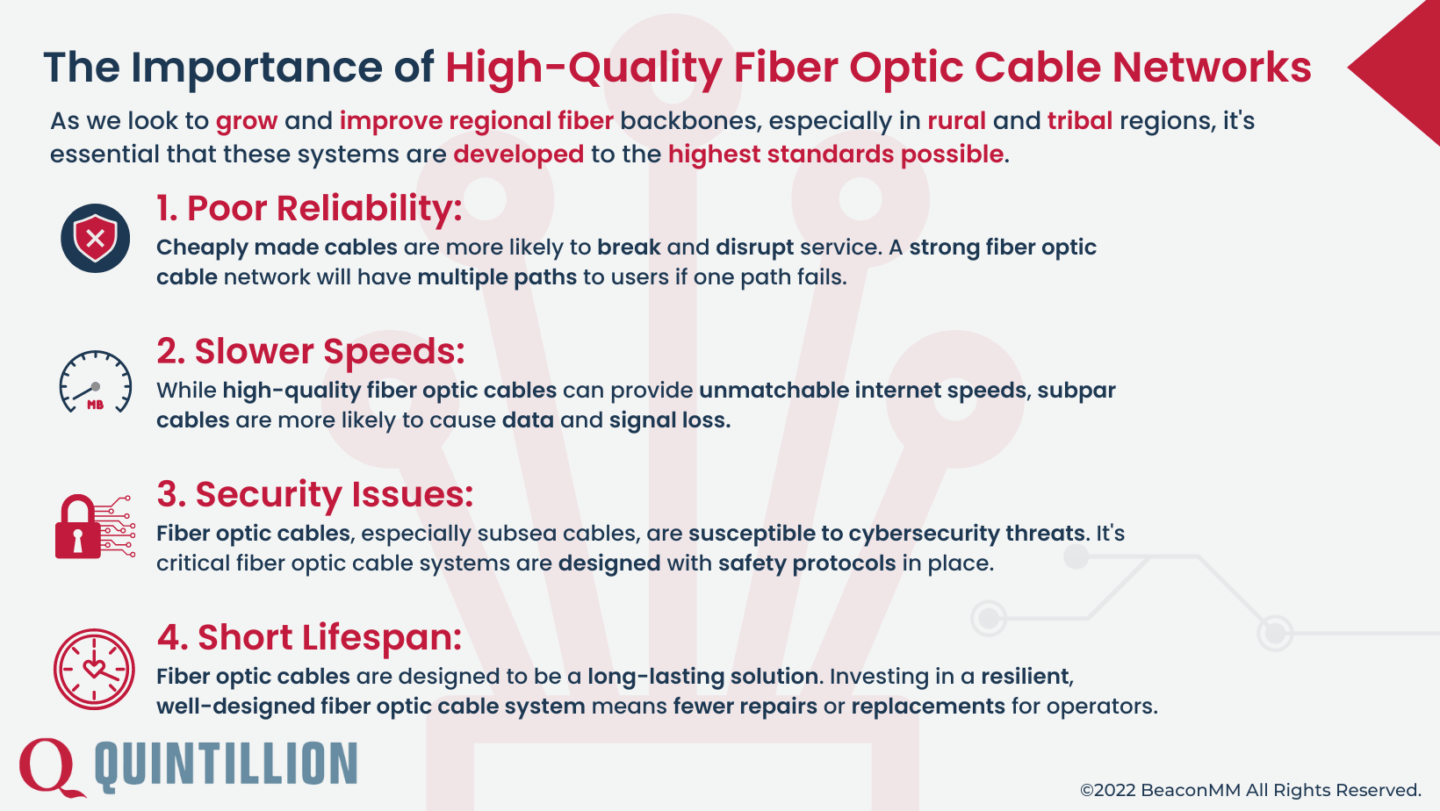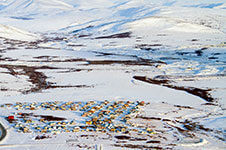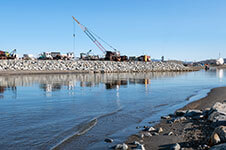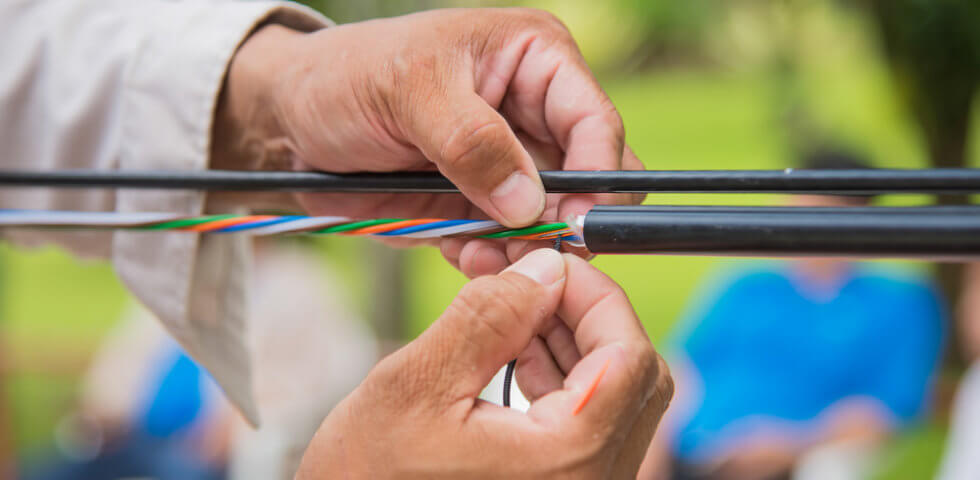Fiber optics is the gold standard of connectivity, but not all fiber optic cables are created the same. And in a region as essential to national security and global connectivity as the North American Arctic, only the most resilient fiber optic cable system will do.
This has been Quintillion’s mission from the start. Quintillion has not only brought fiber optics to unserved Alaskans in the northernmost region of the state, but we’ve also endeavored to build this system with only the best, consciously sourced materials. It is imperative for Alaskan consumers to have the necessary digital tools to connect with their community and the world beyond their town borders, and the US military players in the Arctic are only as effective and competitive as their ability to communicate. We built our system in Alaska with resiliency, security, safety, and resiliency in mind, and future phases will continue to meet Quintillion’s exceptionally high standards.
Unfortunately, cheaply made telecommunications materials, while an attractive choice many companies, have flooded the market. There are significant costs involved in building a fiber optic cable system, and the COVID-19 pandemic put a strain on the production of vital components for subsea cables — hiking up prices and placing a backlog on parts.
As Quintillion and other private telecommunication companies worldwide seek opportunities to close the digital gap and better connect the world, it is crucial to take the proper steps to ensure these networks are reliable and safe. However, cheap, Chinese-made fiber optic cables pose a significant threat to the American telecommunications market and national security. The threat comes from the result of using poor quality Chinese products which would impact the longevity and reliability of a fiber optic system.
Why Chinese-Made Telecommunication Equipment Poses a Problem
Chinese-made telecommunication products have significantly impacted the fiber optics market, making it difficult for American fiber optical suppliers to compete. Additionally, there are inherent cybersecurity risks that come with using this equipment. Equally disconcerting to the quality issue is the potential for the Chinese company to be connected and influenced by the Chinese government’s intelligence operations.
Chinese Control Over the US Fiber Optics Market
Chinese telecommunication giants, like Huawei and ZTE, have historically been large suppliers in the American market. American companies often have higher operating and material costs than Chinese suppliers. As such, American suppliers may be unable to sell materials and parts at a competitive price. This business practice of flooding the market with cheaper quality parts and below market prices can force reputable suppliers who make a higher quality product out of the market. The result? China can gain full control over the fiber optics market in the United States.
Chinese Espionage and Cybersecurity Risks
Chinese-made telecommunications equipment poses significant risks to national security and cybersecurity for individuals, businesses, and government organizations. A justifiable fear is that China could be using telecommunications equipment sold in the United States to spy on American consumers in an attempt to overpower, sabotage, or otherwise harm the US.
In 2020, Christopher Wray, the director of the FBI, released a statement outlining the severity of this threat, “The greatest long-term threat to our nation’s information and intellectual property, and to our economic vitality, is the counterintelligence and economic espionage threat from China. It’s a threat to our economic security — and by extension, to our national security.”
Director Wray went on to describe the risks this espionage poses to individual Americans, claiming that “if you are an American adult, it is more likely than not that China has stolen your personal data.”
In this statement, Director Wray also identified three key takeaways that sum up the motivations and tactics used by the Chinese government, which presents a national security threat to Americans:
- The Chinese government’s ultimate goal is to become the world’s only superpower and undermine the United States’s position of power.
- China uses various “sophisticated techniques” that range from theft, employing spies in the US, cyber security breaches, and more.
- Many Chinese businesses are state-owned, and even privately owned companies are legally required to provide the Chinese government with any data they request.
There is hard proof that China has stolen data and is actively doing so, and in the past, this has involved major Chinese telecommunication companies, such as Huawei.
In 2021, the Federal Communications Commission (FCC) released a list of Chinese telecommunication companies that pose a serious risk to Americans. This is a growing list that has multiplied in 2022:
- Huawei Technologies Company
- ZTE Corporation
- Hytera Communication Corporation
- Hangzhou Hikvision Digital Technology Company
- Dahua Technology
- AO Kaspersky Lab
- China Mobile International USA Inc.
- China Telecom (Americas) Corp.
- Pacific Network Corp. and subsidiary ComNet (USA) LLC
- China Unicom (Americas) Operations Limited
Removing Chinese Components From American Fiber Optic Networks
Now that these Chinese telecommunication companies have been declared a risk, what does this mean for American fiber optics companies that purchased components from popular Chinese companies like Huawei? While many companies recognize the seriousness of the risk that Chinese telecommunication parts pose, replacing these parts is a challenge.
Many of the carriers using Chinese-made telecommunications equipment are smaller companies located in rural areas of the United States. In July, the FCC voted to fund a $1.9 billion program enabling carriers to remove equipment from Chinese companies deemed a risk. However, the FCC declared at a later date that they would need an additional $3 billion to fund this program entirely, only covering about 40% of the costs to remove all equipment that poses a threat.
Without this reimbursement, many of these small telecommunication companies claim they can’t afford to remove, upgrade, or replace problem equipment. Policymakers are still struggling to find a solution to fund the replacement and transition of American systems containing these risky Chinese products.
The Importance of High-Quality Fiber Optic Cable Networks

The United States government has identified the nation’s need for high-quality, affordable broadband systems that can provide Americans in every part of the country with a reliable and fast internet connection. The recent Infrastructure Investment and Jobs Act provides $65 billion to expand these systems.
As we look to grow and improve regional fiber backbones, especially in rural and tribal regions, it’s essential that these systems are developed to the highest standards possible, using high-quality, responsibly sourced fiber optic materials.
Poorly made fiber optic cables or weakly designed systems can have a devastating impact, including:
- Poor reliability: Cheaply made cables are more likely to break and disrupt service. For instance, poorly made cables may be less resistant to water damage, as well as prone to corrosion or breakage. Network diversity also affects service reliability. A strong fiber optic cable network will have multiple paths to users, so if one path fails, there are multiple options to deliver data.
- Slower speeds: While high-quality fiber optic cables can provide unmatchable internet speeds, subpar cables are more likely to cause data and signal loss, which users will experience as poor-performing internet.
- Security issues: Fiber optic cables, especially subsea cables, are susceptible to cybersecurity threats (even outside China’s spying operations). Quintillion’s critical fiber optic cable systems are designed with safety protocols in place, including both physical barriers, such as protected landing stations and safeguarded cables, as well as digital protections, such as data encryption.
- Short Lifespan: Fiber optic cables are designed to be a long-lasting solution. However, poorly made cables or a bad network design can result in cables failing much sooner than average. Investing in a resilient, well-designed fiber optic cable system means fewer repairs or replacements for operators.
Time has shown that investing in high-quality fiber optic cables is often the safest and best choice for telecommunication providers as they purchase and construct these networks. While cheaper alternatives, such as Chinese-made equipment, can help companies get systems up and running more on the cheap, the risks are numerous. There is too much at stake to take shortcuts.
#SupplyChain #RiskManagement #Criticalinfrastructure
Want to learn more about Quintillion’s resilient fiber optic cable network? Reach out to our team or keep up with the Quintillion Blog for more industry insights and company updates.















